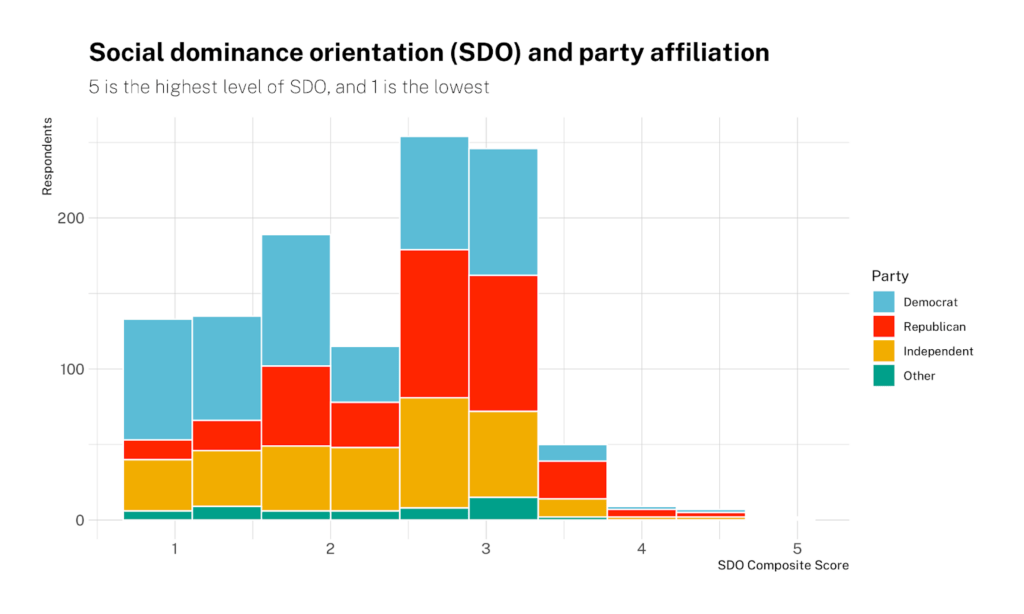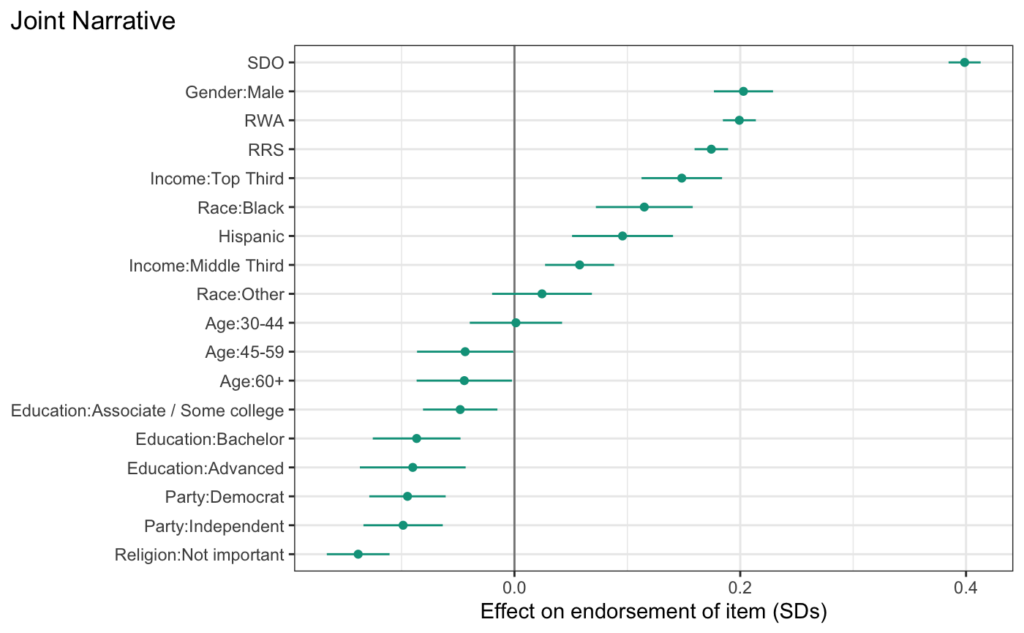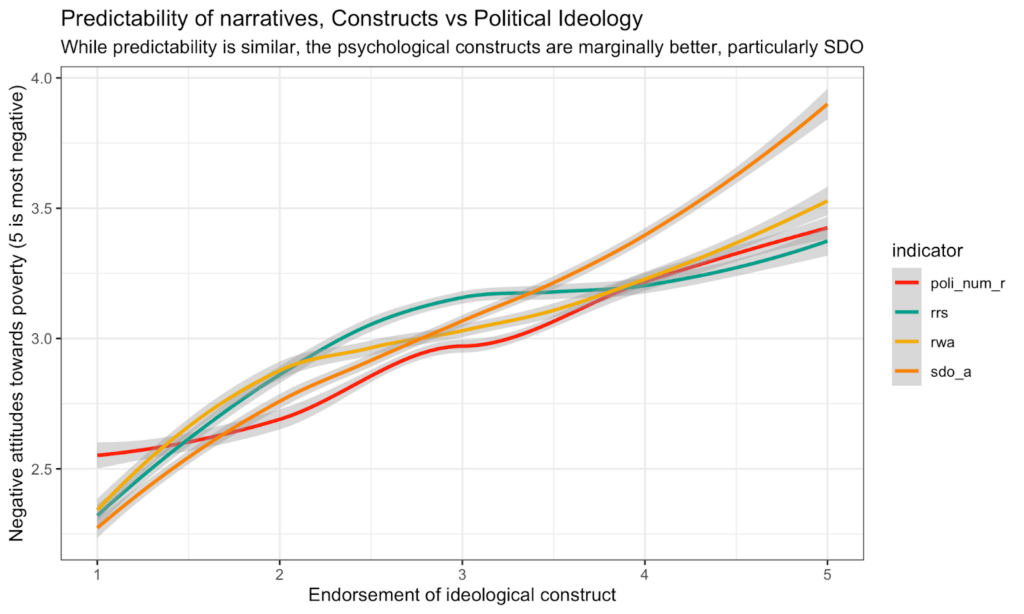Worldview predicts endorsement of harmful poverty narratives
In our last blog post, we talked about how the endorsement of poverty narratives varies based on demographic variables like education, income, or religious belief. Here’s a recap of the key insights:
- People generally recognize structural barriers as contributors of poverty.
- Most people do not believe that people living in poverty have character flaws
- People also generally believe in meritocracy, that the American Dream is attainable, and that working hard will lift people out of poverty.
- People believe that some anti-poverty government programs require barriers to usage because users may commit fraud.
Here, we’ll cover the influence of something broader: ideology and worldview. Over the past few months, our narrative change team has been looking at how constructs such as social dominance orientation, right-wing authoritarianism, and racial resentment relate to harmful poverty narratives in the United States.
The bottom line:
- Overall, we find that these psychosocial constructs are some of the best predictors of attitudes towards populations who live on low incomes.
- They are far more predictive than any demographic variable we’ve looked at, and together they explain a large chunk of the variation in poverty narrative endorsement and other measures of bias, like fraud perception in social benefits programs.
But what are these psychosocial constructs:
Social dominance orientation (SDO) measures people’s opposition towards equality for everyone in society, known as anti-egalitarianism, and their willingness to maintain (and increase) dominance of their group versus others. If you are curious about the social dominance orientation questionnaire, you can find it here.
Right-wing authoritarianism (RWA) is broadly defined as the tendency to submit to traditional authorities and values, as well as punish those who disagree. If you are curious about the right-wing authoritarianism questionnaire, you can find it here.
Racial resentment (RRS) is a measure of symbolic racism. It attempts to measure whether people hold underlying prejudice towards any ethnicity and in the U.S most often focuses on attitudes toward Black Americans. Racial resentment is a difficult construct to measure and there are a variety of alternative measures for it, but the questionnaire we used is here.
All three of these constructs have been linked to American right-leaning politics. Patrick Murray at Monmouth Polling looked at social dominance orientation and found that Trump supporters were more likely to score high on that measure. Recent work has also shown that people high in right wing authoritarianism were much more likely to support Donald Trump in the 2016 presidential election, and also more likely to believe in the (demonstrably false) fraud allegations in the aftermath of the 2020 elections (Easley, 2021).
Authoritarianism and anti-egalitarianism exists across the political spectrum
However, this does not mean that authoritarianism and anti-egalitarianism are exclusive to right-leaning politics. Based on our own research, there are respondents high in social dominance orientation and right wing authoritarianism across the political spectrum. We analyzed nationally-representative survey data from 1141 respondents in which we asked questions about poverty narratives, worldview, and partisanship. We find that, although there is a clear pattern where more Republicans rate higher in social dominance orientation and right wing authoritarianism than Democrats, there are a fair amount of liberals that also score highly on social dominance orientation.
Figure 1:

Figure 2:

Figures 1 and 2 above show that more Republicans rate as high in social dominance orientation, while Democrats and independents are distributed more evenly across the spectrum. This distribution of social dominance orientation from both right and left-politics is problematic since we know people rely on stereotypes and stories (hence the need for narrative change work) and they might consider people on the left as a “non-factor” in changing narratives. We know social dominance orientation is related to these harmful narratives and lack of support for social programs (keep reading to find out more!) and so understanding that high social dominance orientation exists across the political spectrum allows better targeting of persuasive messages.
Social dominance orientation is more predictive of harmful poverty narrative support than political affiliation
Conventional wisdom would hold that whether you think poverty is caused by individual failures or structural factors is highly correlated with whether you identify as a Democrat or Republican. And party identification is indeed associated with how you explain poverty in the expected way: Democrats are more likely to agree with structural factors, while Republicans focus on individual decisions. However, we find that the measure of social dominance orientation is more predictive of respondent’s perceptions about the causes of poverty than political party or any other socio-demographic characteristic.
Looking at Figure 3, we note that social dominance orientation is more predictive – by a wide margin – of an individual’s endorsement of negative poverty narratives compared to any other demographic characteristic. Even though social dominance orientation is by far the most predictive, right wing authoritarianism and racial resentment are not far off, holding the #3 and #4 spots, respectively, in our model.
We also explore the correlation between endorsement of negative poverty narratives and worldview measures (SDO, RWA, RRS) in comparison to political ideology. You can see in Figure 4 that the correlations between each of these constructs and the joint poverty narrative score are all similar. Social dominance orientation and right wing authoritarianism are slightly better correlated with our joint poverty score – especially at the highest and lowest scores – compared to partisanship. Racial resentment is similarly correlated to the joint poverty score as ideology.
Figure 3:

Figure 4:

How predictive are they?
In a previous post here, we defined the main poverty narratives we’ve encountered: for example, the individualistic narrative, which is the idea that individual action and character traits are the cause of poverty. Of the five identified (individualistic, structural, paternalism, welfare exploitation, and meritocracy), it turns out that social dominance orientation, right wing authoritarianism, and racial resentment are especially predictive of the individualistic, welfare exploitation, and meritocracy narratives. People who score higher in any of the three constructs separately are much more likely to endorse negative narratives about people who live in chronic scarcity. Of these, social dominance orientation remains the most predictive (correlation of 0.59), followed by right-wing authoritarianism (0.41) and racial resentment (0.39).
Social dominance orientation, right wing authoritarianism, and racial resentment are part of a large group of ideological constructs related to discrimination and endorsement of harmful poverty narratives (some of which we have tested in other surveys, be on the look out for future posts). If this cluster of constructs are so predictive, are we looking at something redundant? That is, do these constructs retain individual predictive power when they are all included in a regression? They do! Each of these constructs are still powerful predictors, even when you control for the other constructs.
This is not to say that social dominance orientation, racial resentment and right wing authoritarianism are uncorrelated; they most certainly are related. But they are not measuring the same thing, as the literature suggests (Crawford et al., 2013). Social dominance orientation and right wing authoritarianism refer to constructs related to ingroup and outgroup dynamics. Social dominance orientation is about outgroup dynamics, the preference for control and dominance over groups perceived as others. Right wing authoritarianism is about ingroup dynamics, with a preference for submission to an ultimate authority, in this case authorities related to right wing ideology. The positive relationship between social dominance orientation and right wing authoritarianism are not hard to imagine: a strong tie to an ingroup authority often leads to a distrust of outgroups and vice versa (cults, religious extremism, etc). But this is not mutually exclusive; people can have a strong ingroup authority that advocates for outgroup equality and people can have a strong disdain for others and want control of everyone. In addition, racial resentment describes specific patterns of belief about a historically defined outgroup in the U.S. context, but these attitudes do differ from perceptions of in- versus outgroup dynamics generally.
Implications and Conclusion
Knowing how social dominance orientation, right wing authoritarianism, and racial resentment work in relation to poverty narratives helps us incorporate them as target variables for narrative messaging and persuasion. Most targeting focuses on a narrow set of demographics, but these findings open up a whole new conversation about what can be targeted. A practical application could even be in thinking about voter turnout. Campaigns to increase voter turnout typically incorporate socio-demographic factors like race or income, but in recent years understanding what the most movable voter is has included things like social dominance orientation and right wing authoritarianism. Notably, in the 2016 elections, social dominance orientation and right wing authoritarianism were highly predictive of voter activity among Trump supporters (Pettigrew, 2017). If we could use these constructs to predict who votes, then they could also be used to get people to the polls or to vote for policies that promote generous social policy; and this could be even more powerful given that these constructs don’t exist exclusively in any one side of the political spectrum.
But how can we get more concrete? How do we tie ideologies and narratives to the way people behave and how people want the world to work? For the next blog post, we do just that by focusing on administrative burden; we go from the stories people believe to how they want to place restrictions on access to programs that would otherwise limit the negative impacts of living in poverty.


